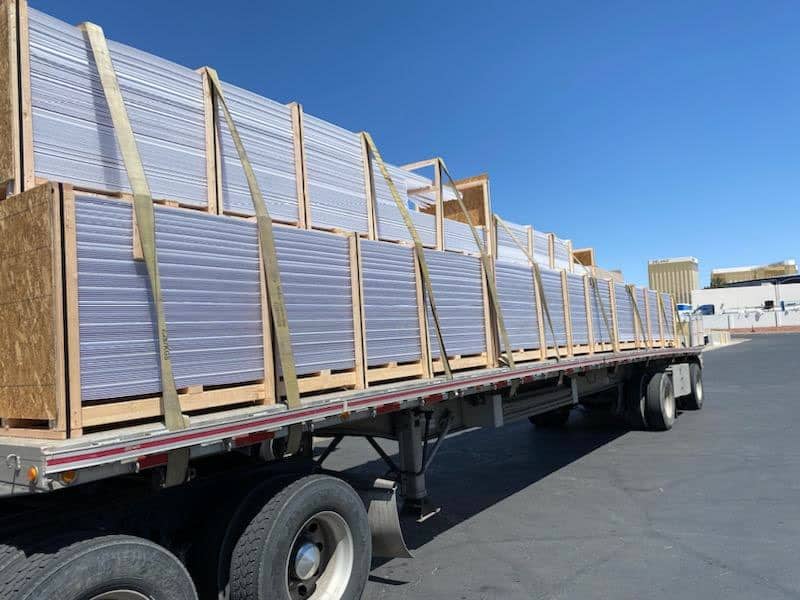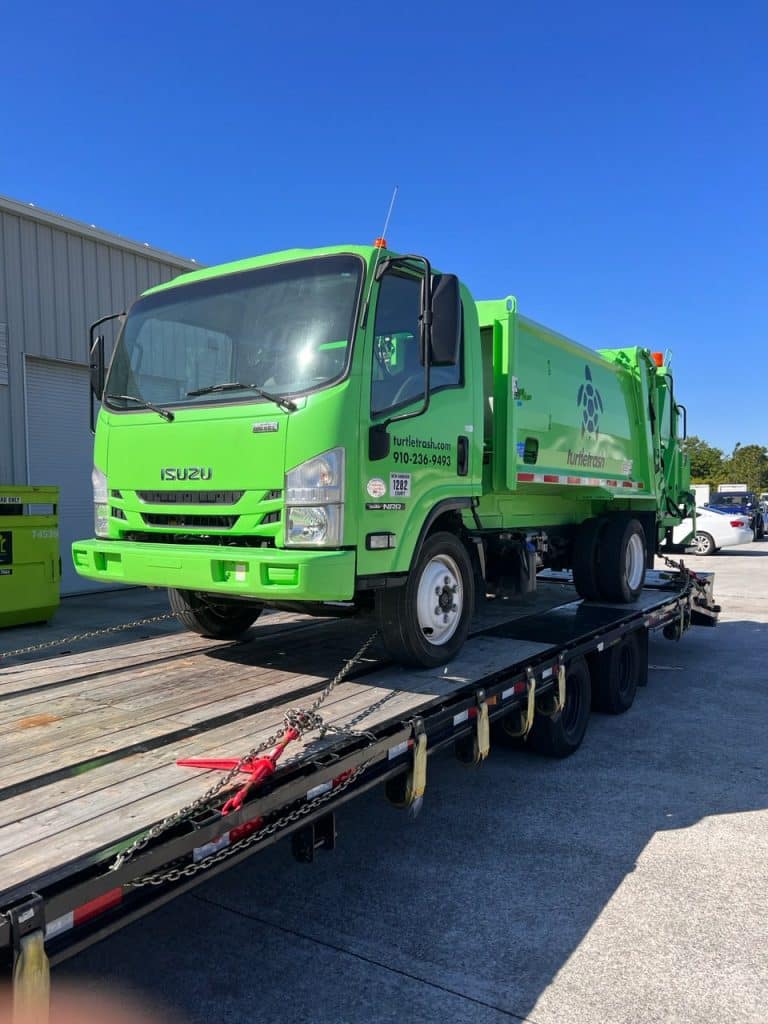Flatbed Trailer Weight Limits
Freedom Heavy Haul can offer expedited Pickup and Delivery for any size shipment anywhere in the USA. Contact us today for No Hassle, No Pressure Pricing.
In the logistics and transportation industry, understanding and adhering to flatbed trailer weight limits is crucial for safety, compliance, and efficiency. This guide provides a comprehensive overview of flatbed trailer weight limits and distribution, regulatory compliance, and best practices for loading and maintaining flatbed trailers.
Understanding the Importance of Flatbed Trailer Weight Limits
Proper weight distribution is vital for the safety and stability of flatbed trailers. Uneven or improper distribution can lead to numerous problems, including reduced vehicle control, increased wear on the trailer, and heightened risk of accidents.

Essentials of Proper Weight Distribution
Ensuring a balanced load on a flatbed trailer is essential. The weight should be distributed evenly across the axles to prevent overloading any single point. This balance helps maintain the trailer’s stability, reduces strain on the vehicle’s braking and suspension systems, and ensures a smoother, safer ride.
Impact of Weight Distribution on Road Safety
Poor weight distribution can significantly affect road safety. An unevenly loaded trailer is more prone to swaying, which can lead to loss of control, especially in adverse weather conditions. It also increases the likelihood of rollovers and makes braking more difficult, posing a risk not only to the truck driver but also to other road users.
Expert Tips for Optimal Weight Placement on Trailers
Correct weight placement on a flatbed trailer is not just about adhering to legal weight limits; it’s about optimizing the load for the safest and most efficient transport. Here are some expert tips for achieving this.

Determining Total Weight of Tractor and Trailer
The first step in load management is knowing the combined weight of your tractor and trailer. This knowledge helps ensure you stay within legal weight limits and aids in correctly distributing the cargo’s weight.
Identifying the Center for Ideal Weight Distribution
Locating the center point for weight distribution is crucial. Ideally, the heaviest parts of the load should be placed over the trailer’s axles. This placement helps maintain balance and reduce the risk of axle overloading.
Post-Loading Weight Assessment and Adjustments
Once the trailer is loaded, a final weight assessment is necessary. This assessment often involves weighing the loaded trailer at a certified weigh station. If the weight exceeds legal limits or is unevenly distributed, adjustments should be made before departure.
Maximizing Load Stability During Transit
Ensuring load stability during transit is key. This involves using tie-downs and other securing methods to prevent cargo movement, which can affect weight distribution during the journey.
Adhering to Weight Limits for Road Safety
Staying within the specified weight limits is not just a legal requirement but a critical aspect of road safety. Overloading can lead to tire blowouts, brake failures, and reduced maneuverability.
Regulatory Compliance for Flatbed Trailers
Adherence to state and federal regulations regarding flatbed trailers is mandatory. These regulations vary but generally include limits on weight, height, and length of both the load and the trailer.
Understanding Different Weight Regulations
Weight regulations for flatbed trailers can vary depending on the state or region. It’s important for drivers and fleet operators to be familiar with these variations to ensure compliance on cross-country routes.
Navigating State and Federal Weight Limit Laws
Federal laws provide a baseline for weight limits, but states may have additional restrictions. It’s crucial for drivers to know these laws, especially when traveling through multiple states.
Flatbed Trailer Types and Their Weight Capacities
Different types of flatbed trailers are designed to handle various weights and cargo types. Knowing the specifications and capacities of each is vital for safe and efficient loading.

Standard Flatbed Trailer Specifications
A standard flatbed trailer, typically 48 to 53 feet in length, can usually carry a maximum legal load weight of around 48,000 pounds, depending on the tractor weight.
Single Drop Flatbed Trailer Features
Single drop (or step deck) trailers allow for taller cargo, usually up to 10 feet in height, without exceeding height limits. Their weight capacity is similar to standard flatbeds but can vary based on the length and design.
Double Drop Trailer Characteristics
Double drop trailers are designed for extremely tall or heavy loads. They have a lower center section (the “well”) which allows for the transportation of items up to 12 feet high. Weight capacities can vary, but they are typically designed for heavier loads than standard flatbeds.
Dimensions of Extendable Flatbed Trailers
Extendable flatbed trailers, also known as stretch flatbeds, are used for oversized loads. They can extend to accommodate longer cargo, with varying weight limits based on their extended length.
Single Drop Extendable Flatbed Specifications
This type combines the features of a single drop and extendable trailer, ideal for long and slightly taller loads. Understanding its specific weight capacity and extended length is important for proper loading.
Double Drop Extendable Flatbed Features
Double drop extendable flatbeds are designed for long, tall, and heavy loads. They offer flexibility in both length and height, making them suitable for specialized heavy cargo.
Specific Weight Capacities of Common Flatbed Trailers
Knowing the specific weight capacities of common flatbed trailer sizes is crucial for planning and load management.
Weight Capacity for a 48 ft Flatbed Trailer
A 48-foot flatbed trailer typically has a weight capacity of around 48,000 pounds, but this can vary based on the trailer’s construction and the weight of the tractor.
Weight Capacity for a 53 ft Flatbed Trailer
A 53-foot flatbed trailer can usually carry slightly more than a 48-foot trailer, often up to 52,000 pounds, depending on the factors mentioned earlier.
Key Considerations for Loading Flatbed Trailers
Effective loading of flatbed trailers involves more than just balancing weight. It includes considerations for height, length, and overhang to ensure safety and legal compliance.
Maximizing Freight Height on Flatbed Trailers
The maximum freight height typically allowed on flatbed trailers is 8.5 to 9.5 feet, but this can vary based on the trailer type and the roads being traveled.
Guidelines for Overhang on Flatbed Trailers
Overhang regulations are important for safety. Most states allow a certain amount of overhang at the rear of the trailer, but this varies, and permits may be required for excessive overhang.
Determining Pallet Capacity for a 53 ft Flatbed Trailer
A 53-foot flatbed can typically accommodate up to 26 standard pallets, arranged in a double-stacked formation. However, weight and height limits must always be considered.
Additional Safety and Compliance Considerations
Beyond the basic rules of weight and size, there are additional considerations for ensuring the safe and legal operation of flatbed trailers.
Ensuring Load Security and Compliance
Securing the load properly is essential for safety. This involves using straps, chains, and other securing devices according to legal requirements and best practices.
Periodic Maintenance Checks for Weight Management
Regular maintenance of the flatbed trailer, including checks on the axles, suspension, and tires, is vital for safe weight management and overall road safety.
Training for Drivers on Weight Management
Finally, ongoing training for drivers on weight management, load securing, and regulatory compliance is key to ensuring safety and efficiency in flatbed trailer operations.







